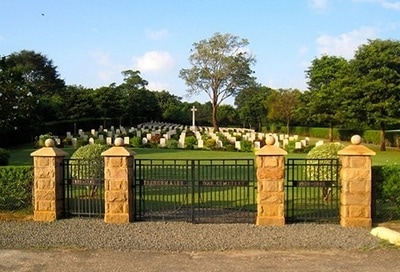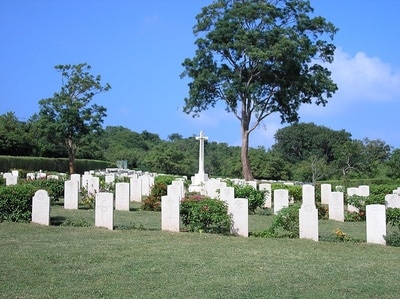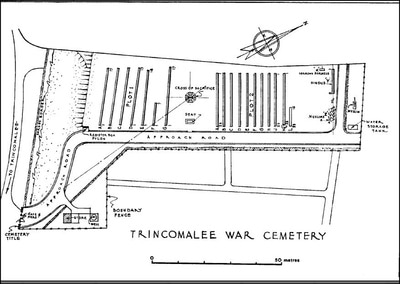TRINCOMALEE WAR CEMETERY
Trincomalee
Sri Lanka
Location Information
From the main A6 road, just south of the town of Trincomalee, turn left onto the North East Coast Road, also known as the Nilaveli Road. The cemetery is approximately 6 kilometres along this road on the right (eastern) side.
Visiting Information
Before considering a visit to Sri Lanka the Commission strongly recommends that you check the advice given by the Foreign & Commonwealth Office on the travel section of their website:
www.fco.gov.uk/en/travel-and-living-abroad/travel-advice-by-country/
This site is open between 07:00 and 16:00 every day. Access outside these hours can be made via the resident caretaker. Wheelchair access possible via main entrance.
Historical Information
Trincomalee is a seaport on the north-eastern coast of Sri Lanka (Ceylon) and was formerly a naval station. After the fall of Singapore it became a naval base of importance to our command of shipping in the Bay of Bengal and the Indian Ocean.
The cemetery was originally the Combined Services Cemetery, but was taken over by the Admiralty from the military authorities in April 1948 for use as a permanent naval cemetery. On the withdrawal of United Kingdom Forces from Ceylon it became the property of the Ceylon Government who have granted the Commission security of tenure in perpetuity.
Save for a few post-war and non-war graves it is purely a war cemetery, and service war graves were transferred to it from Trincomalee (St. Mary) Churchyard; Trincomalee (St. Stephen's) Cemetery, Kottadi Cemetery, Jaffna; and Vavuiyna Combined Cemetery. A special memorial commemorates a naval man buried in Trincomalee (St. Stephen's) Cemetery whose grave could not be found.
The non-war graves are those of men of the Merchant Navy whose death was not due to war service, and of civilians, of whom some were employees of the Admiralty; while the post-war graves were dependents of servicemen, civilian employees of the Admiralty and dependents of such employees.
Cemetery pictures used with the permission of the Commonwealth War Graves Commission
From the main A6 road, just south of the town of Trincomalee, turn left onto the North East Coast Road, also known as the Nilaveli Road. The cemetery is approximately 6 kilometres along this road on the right (eastern) side.
Visiting Information
Before considering a visit to Sri Lanka the Commission strongly recommends that you check the advice given by the Foreign & Commonwealth Office on the travel section of their website:
www.fco.gov.uk/en/travel-and-living-abroad/travel-advice-by-country/
This site is open between 07:00 and 16:00 every day. Access outside these hours can be made via the resident caretaker. Wheelchair access possible via main entrance.
Historical Information
Trincomalee is a seaport on the north-eastern coast of Sri Lanka (Ceylon) and was formerly a naval station. After the fall of Singapore it became a naval base of importance to our command of shipping in the Bay of Bengal and the Indian Ocean.
The cemetery was originally the Combined Services Cemetery, but was taken over by the Admiralty from the military authorities in April 1948 for use as a permanent naval cemetery. On the withdrawal of United Kingdom Forces from Ceylon it became the property of the Ceylon Government who have granted the Commission security of tenure in perpetuity.
Save for a few post-war and non-war graves it is purely a war cemetery, and service war graves were transferred to it from Trincomalee (St. Mary) Churchyard; Trincomalee (St. Stephen's) Cemetery, Kottadi Cemetery, Jaffna; and Vavuiyna Combined Cemetery. A special memorial commemorates a naval man buried in Trincomalee (St. Stephen's) Cemetery whose grave could not be found.
The non-war graves are those of men of the Merchant Navy whose death was not due to war service, and of civilians, of whom some were employees of the Admiralty; while the post-war graves were dependents of servicemen, civilian employees of the Admiralty and dependents of such employees.
Cemetery pictures used with the permission of the Commonwealth War Graves Commission







